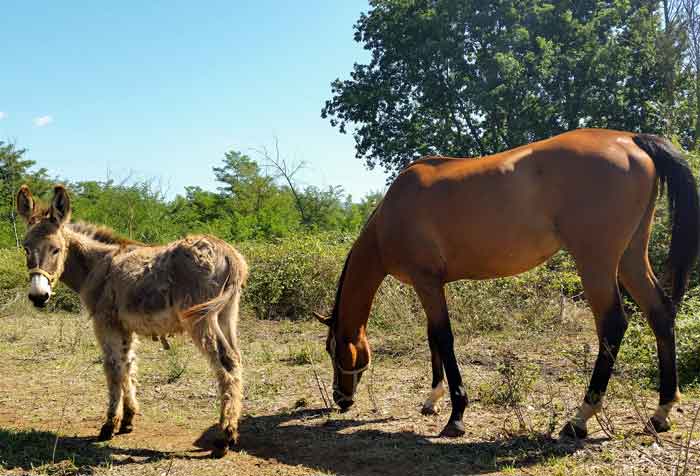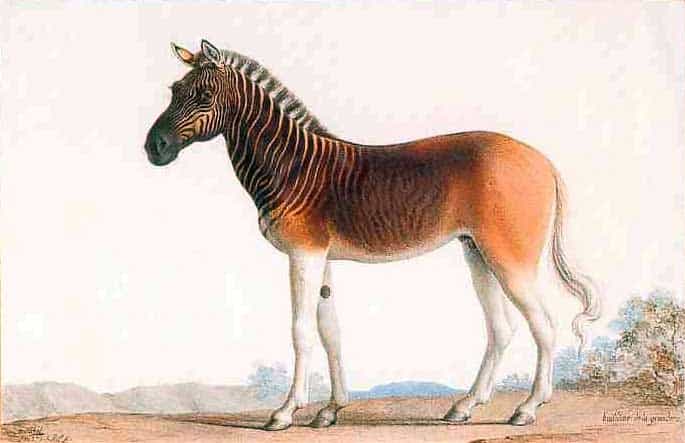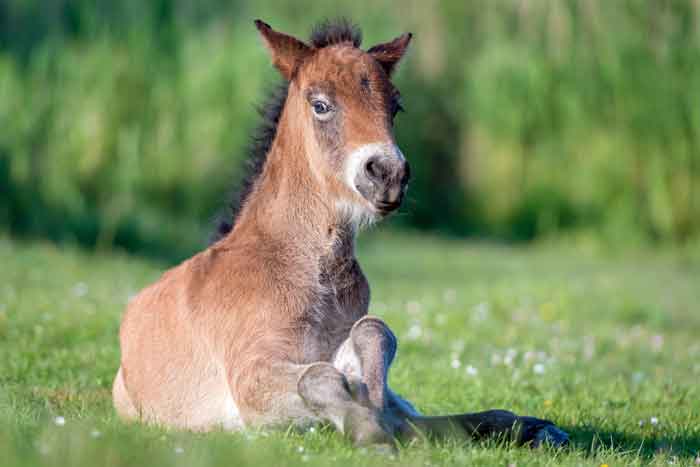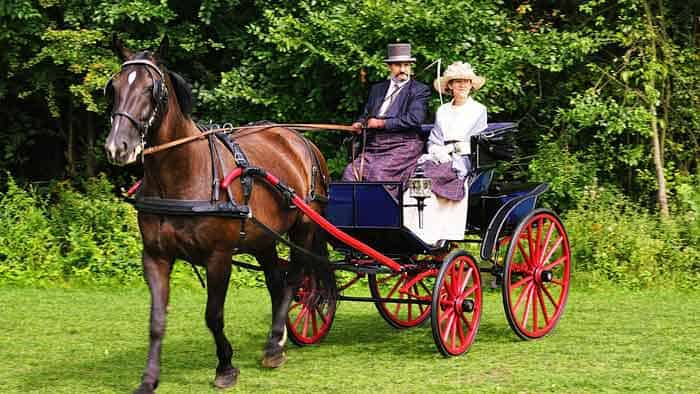When you take a look at horses and donkeys there are some obvious similarities. But there are also major differences.
What are the main differences between donkeys and horses?
Horses are taller and easier to ride than donkeys. The saddle does not sit tight on a donkey due to the lack of withers. Donkeys can carry twice their own body weight which is a lot more than horses.
But of course not much more to say than this so let’s dive in a little deeper and look at some very interesting facts!
Table of Contents
In this article, we will lay out exactly what the main differences and similarities are between horses and donkeys.

5 Similarities Between Horses & Donkeys
The two breeds come from the same ancestors as we would look at in a second. First, we will take a closer look at the similarities between horses and donkeys.
1) They share the same ancestors
Horses and donkeys have the same ancestors in the family tree. This is something we will come back to later in the article.
2) Physical similarities
When we take a look at the donkey beside a horse it’s obvious that they are quite similar in physical appearance. They are (almost) built the same way and they both have the characteristic forward faced ears as well as a mane across the neck.
They also both have a strong bite and strong teeth.
3) The feet are similar
Horses and donkeys both have one hoof per foot. This also means that you can place a horseshoe on both animals.
They have strong feet that are perfect for caring for loads or riders.
4) They work great with humans
Donkeys and horses alike are great with humans. All through history, we find reports of both horses and donkeys being used as work animals on the farm.
We can even find reports of donkeys in the Bible where Jesus enters Jerusalem on a horse. The disciples are asked to find a donkey in a nearby city and it seems like this is a natural thing for them to do.
So it’s fair to assume that people in the ancient Middle East had lots of donkeys inside the town walls to help them carry a load and carry out daily tasks.
5) They are social animals
Donkeys, as well as horses, prefer social interaction with other animals as well as humans. They love to be cuddled and they like to be talked to.
This social interaction is also very important in order to keep the animals healthy and able to reproduce.
This is also why you typically find these animals among humans. A not so distant relative is the zebra and it’s very different regarding this matter. Zebras prefer to keep to themselves and they never do well among humans. They can’t be trained and they can be taught to carry a human.
Go here to read more about the differences and similarities between zebras and horses.
7 Differences Between Horses & Donkeys
Horses and donkeys look like the same species but that is a list of differences which we will look at here.
1) The mane is different
The mane of a horse has long pretty hair. So long that you can braid it and do all social things with it. This is not the case with the donkey.
The mane of a donkey is shorter and stiffer and you won’t be able to braid and organize the hair. It’s stiff and will probably just stand up no matter what you do with it. In that regard, the donkey is more similar to a zebra.
2) Donkeys prefer to ride backward in trailers
This is a funny fact that many people are not aware of Donkeys.
Donkeys prefer to ride bike words when you put them into a horse trailer. You also should be very careful about straining them because they need more freedom than a horse (during travel).
You should aim to arrest every 4-5 hours. The donkey will need to get some fresh air and get out of the trailer for at least 45 minutes. The animal might not want to drink anything during the transport and this is typically not a problem.
Donkeys can go a long time without water as they are bread around a very warm climate more similar to camels. They can actually lose around 30% of their body weight from dehydration without any trouble. It might also refuse to drink anything after several days after being transported.
3) Donkeys are slower
Another difference between donkeys and horses are related to speed.
Donkeys are much slower animals than horses which also has to do with the size of the animal.
Donkeys are much better at caring load at a slow pace then carrying a rider over the fields. Because of this donkeys have typically been used to carry goods like corn and food from the market to the home.
4) Maximum load varies
You will normally be able to pack a donkey pretty tight. Due to its strong construction,n it’s able to carry up to twice its own body weight. This is quite impressive!
You do need to pay careful attention to the animals though because not all donkeys are able to do this. Especially not over a longer distance.
It’s important always to pay attention to the breathing of the animal. If the animal is stressed out or packed too heavy you will be able to tell from the heartbeat and the breathing.
5) Differences in tempers
The donkey is more stubborn. They are also reportedly noted to be more intelligent but people often choose a horse because they are easier to teach and control.
This simply has to do with genetics. A donkey is almost always by definition more independent and not so willing to do what you want. It might not want to move at all and sometimes you just have to leave it alone.
Horses, on the other hand, are pack animals. This means they are used to having a leader or a master of the group. When you are teaching at the horse you become its new master and this is something that’s not possible with the donkey. At least not to the same extent as with horses.
Because the donkey is so independent you should pay close attention to any signs of pain. It might not show any signs of pain at all so if it looks like it is suffering things might be worse than they appear.
6) Differences in physical appearance
Donkeys are lower than horses. A fully grown donkey will be around 36 to 54 inches (90- 137 cm) from the withers to the hoof. Horses, on the other hand, are around 63 inches on average (160 cm).
This means that donkeys are harder to ride and the horse is a much more efficient animal to ride over longer distances.
It’s also harder to ride a donkey as it’s not as sturdy and comfortable to sit on compared to a horse. You will typically need a special saddle for a donkey because the arched part of the back is shorter too.
7) Different sounds
Donkeys are famous for saying “Yee-Haa”. You have probably heard it. It sounds quite hilarious and is very different from the sounds of a horse.
Horses say “neigh” and also have a more blowing types sound they do all the time.
This might have to do with the fact the donkeys have a tighter nasal passage. This also means that veterinarians have to use smaller tubes when they are examining the animal’s air channels.
Can You Ride Donkeys & Mules?
Here’s an image of a Mule. The result of a horse mating with a donkey:

You can ride a donkey and the mule as long as you are paying attention to how much load it can carry. But you might not want to do so because they are not always willing to listen to you and let you be the master.
Horses, donkeys, and mules will typically be able to carry up to 20% of their own body weight. But you need to pay close attention to the briefing of the animals to make sure it’s not stressed or overworked.
So because donkeys and mules are lower and smaller in size compared to the horses they cannot carry the same size as a person.
The withers of donkeys and mules are not able to hold the saddle in place. This means that they are harder to ride as the saddle is not kept in place. So you need to be careful before you saddle up a donkey or a mule.
But there’s and more important point to be made here and this has to do with the temper of the animal. As we looked at above the donkey is more stubborn and independent than the horse.
It might not be willing to do as you tell it to so you might end up at a very slow pace or taking a lot of breaks if you want to ride a donkey.
Why Are Horses & Donkeys Different Species?
Horses and donkeys stem from the same ancestors but that doesn’t mean they are the same species today.
In recent years we have become much better at studying the chromosomes and gene pools of specific animals. Donkeys have 62 chromosomes and horses have 64. This is a very basic difference and it’s something that courses them to have problems with interbreeding.
The two branches of breeds have separated quite a lot to the extent that they are not able to produce a meaningful outcome today. Meaningful in the sense that the outcome can reproduce itself.
Let’s take a closer look at what happens when we crossbreed a horse and a donkey.
Why Can Horses & Donkeys Mate?
Horses and donkeys are fairly the same sizes so it’s physically possible for them to breed.
It happens quite often actually and the outcome is a cute animal that totally looks like a half horse and half donkey.
- When a female horse and a male donkey mate they produce a hybrid called a “Mule”. This is a special type of hybrid that cannot itself reproduce.
- When a male horse breed with a female donkey they produce what is called a “Hinny”. This too is a hybrid animal which also is unable to reproduce
The mule and the hinny end up with 63 chromosomes which is one more than the donkey and one less than the horse. This makes them very special animals and quite unique.
The mule, as well as the hinny, are sterile in almost every case but there have been some cases where a mule has produces a foal. Since 1527 this has been reported to happen around 60 times. And of course, it will also have happened a lot of times without it being reported anywhere.
Are Donkeys & Zebras Related?
Donkey and zebras have common ancestors called “Equus Caballus”. They branch out to horses and “Wild asses” (and zebras) which again branch out to Donkeys.
So, in a way, you can say that donkeys and zebras are related through the same ancestors. You can read more here about the similarities and differences between horses and zebras.






